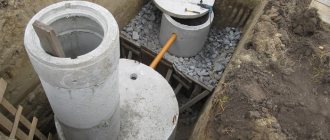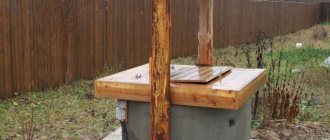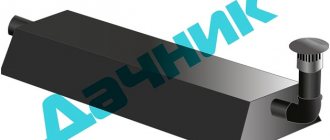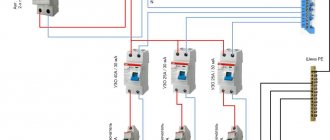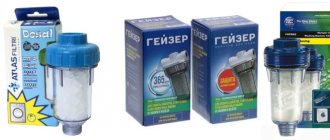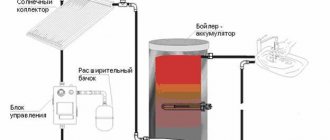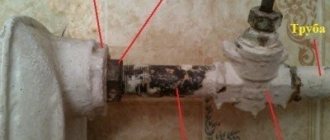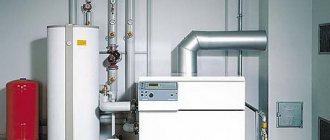Unlike chimneys, the heads of vertical exhaust ventilation shafts are always covered with umbrellas. It is undesirable for precipitation to get inside the air duct - the water has nowhere to go. The essence of the problem: the protective cap creates additional aerodynamic resistance to the air flow. The work of natural hood deteriorates, and if there is a lack of traction, it stops altogether.
The issue is resolved this way: a ventilation deflector is mounted at the end of the pipe instead of the traditional “fungus”. The installation is done by hand, but first you need to select the design of the exhaust device.
Why do you need a deflector?
For a better understanding of the issue, we present data from reference literature. The magnitude of local resistance to air flow in ventilation systems is characterized by the dimensionless coefficient ξ. The greater its value, the stronger the shaped element - umbrella, elbow, gate - slows down the movement of gases through the pipeline.
In relation to our cases, the coefficient is:
- at the exit of the air flow from an open pipe of any diameter ξ = 1;
- if the channel is covered with a classic cap, ξ = 1.3–1.5;
- a Grigorovich umbrella with a diffuser (section expansion) is installed on the pipe, ξ = 0.8;
- Volper nozzle is cylindrical or star-shaped “Shenard”, ξ = 1;
- TsAGI type deflector, ξ = 0.6.
Note. There is no mistake here - even with free release from the shaft, the air stream overcomes local resistance from sudden expansion. Source: Handbook of Heating and Ventilation, 1976 edition.
So, a deflector is a nozzle that, under the influence of wind, creates a vacuum at the outlet of the vertical ventilation duct and thus reduces the aerodynamic resistance to the flow. That is, it acts as a traction amplifier.
In addition, the exhaust device solves the following problems:
- protects the air duct from precipitation;
- does not allow the wind to blow inside the pipe;
- prevents the occurrence of reverse thrust (overturning).
The operating principle of any deflector is based on two effects: vacuum from the wind load and ejection (entrainment) of a slow gas flow by a faster one. Although some foreign manufacturers implement mechanical incentives - they simply equip the umbrella with an electric fan. Let us consider the structure of each design separately.
From this angle it is clearly visible that the cross-section of the lower nozzle pipe does not decrease, which means that the speed and pressure of the gases does not change
Comment. On the Internet, the operation of such caps is often explained by the action of Bernoulli’s law or the Venturi effect. Both physical phenomena involve a narrowing of the air duct, an acceleration of flow and a drop in pressure. In reality, deflectors do not reduce the cross-section of the channel (see photo above) - the vacuum is created solely by the force of the wind.
Features of the device
This is a description of the operating principle of all deflectors, of which there are a huge number of designs. Many devices not only deflect air flows, but also increase the speed of their passage over the head of the ventilation pipe by narrowing the channel, thereby significantly increasing draft (airbrush principle).
Proper use of the deflector helps increase the productivity of the entire ventilation system by up to 20%; it is especially useful on ventilation ducts with large horizontal sections and bends.
In addition, the deflector on the ventilation pipe perfectly protects against the entry of various debris, small birds, insects, and most importantly, precipitation. Basically, the material from which these devices are made is resistant to corrosion. This is galvanized or stainless steel, ceramics or plastic.
Types of nozzles
Now you can purchase ready-made or make your own the following types of caps - traction amplifiers:
- TsAGI deflector with expansion of the ventilation duct - diffuser;
- Volper's cylindrical “mushroom”;
- H-shaped pipe manifold;
- cap - weather vane (popularly - “sycophant”);
- spherical rotary nozzle - the so-called turbo deflector;
- static-dynamic open device of the “Astato” type.
It makes no sense to include and consider ordinary umbrellas on the list - such products do not improve traction, they only cover the pipe section from the rain.
Construction of TsAGI type hoods
This design was developed during the USSR by a specialized research institute (scientific institute). The deflector consists of the following parts (shown in the drawing):
- lower glass with a diffuser (extension) at the end;
- outer body – shell made of cylindrical roofing steel;
- cover in the form of an umbrella;
- cover fastening posts made of metal strips.
The operation of the product is simple: wind blowing the body from any side creates a vacuum zone above the diffuser open at the top. The exhaust gases coming from the mine are carried away by this rarefaction, come out and are picked up by the wind - the ejection principle works.
The table below shows the characteristics of typical TsAGI deflectors - dimensions, performance depending on the wind flow speed.
Comment. Capacity does not include the resistance of the duct system crossing the roof. The actual exhaust volume depends on the height of the pipe and the temperature difference between the indoor/outdoor air.
Of all the static traction amplifiers, the TsAGI cap is recognized as the most effective, despite the venerable age of development. Design advantages:
- ease of manufacture and installation;
- maximum protection against rain and snow, and traction overturning;
- reliability, no rotating parts;
- the direction of wind flows does not matter;
- lowest resistance coefficient (ξ = 0.6).
The disadvantage of the deflector is its dependence on wind speed. If the flows move slower than 2 m/s, the efficiency of the device tends to zero. However, calm weather has a negative impact on the operation of any attachment designed to enhance natural draft in the ventilation duct.
The hood works thanks to wind support - a vacuum appears above the cut of the air duct
Please note: in modern versions of TsAGI factory-made, insulation of the lower glass is provided if the cap is attached to the roof sandwich pipe. Under the “fungus” we see a skirt, although the flow area of the channel does not decrease.
Volper Static Umbrella
This deflector is more of a windproof device than an amplifier of natural draft. Although the nozzle successfully compensates for pressure losses at the flow outlet. The design includes the following elements:
- lower pipe (glass);
- upper cylindrical glass with concave walls;
- cone umbrella;
- connecting strips.
The hood is installed on a round air duct or a rectangular shaft through an adapter. How the Volper ventilation deflector works:
- Direct wind flows are reflected up and down by the concave surface of the upper shell.
- The jet passing between the umbrella and the cut of the glass creates an area of low pressure inside the body.
- The exhaust air changes direction and flows out through the gap under the “skirt”.
The nozzle is inferior to the TsAGI design in efficiency, but better protects the air duct from gusts of wind. Making a curved glass is more difficult, so home craftsmen simply make a cone. To increase productivity, a similar plate in mirror image is placed under the umbrella, as shown in the video:
H-shaped nozzle
This original design is a pipe assembly in the shape of the Russian letter “H”, the hood is connected to the middle of an imaginary crossbar. From whatever direction the wind blows into the open pipes - from above or from below - the faster flow will eject (carry along with it) an air stream from the ventilation riser.
The advantage of the H-shaped deflector is almost one hundred percent protection against wind blowing, reverse draft, moisture ingress and freezing. These advantages are crossed out by no less significant disadvantages:
- Problems with aerodynamics - to go outside, the air travels through 2 90° turns. The losses are compensated by the wind flow, but the traction force increases minimally. Hence the low performance of the exhaust nozzle.
- The device is quite bulky, making it difficult to attach to the pipe.
- The H-deflector doesn't look very nice. Imagine a situation where 2-3 ventilation ducts with similar caps are installed on the roof.
The cap provides maximum protection from the draft being blown out and overturning, but it itself creates considerable resistance to escaping gases
Addition. We missed one advantage of the nozzle - it is easy to assemble it with your own hands from ready-made tees. The product can be used for ventilation of ancillary buildings, for example, a bathhouse or a warm barn.
Turbo deflectors and weather vanes
We have combined these 2 types of attachments into one section due to the similarity of the operating principle:
- A spherical rotary deflector with multiple semicircular blades is rotated by the force of the wind. A vacuum is formed above the head of the pipe (inside the ball), and the efficiency of the hood increases.
- The weather vane with the wing always turns its “back” to the wind, preventing it from being blown into the trunk. A zone of low pressure (aerodynamic shadow) is formed behind the nozzle body; the air stream leaves the vertical channel more readily.
The supporting element of the weather vane hood partially blocks the flow area of the ventilation duct.
In terms of efficiency, dynamic hoods are superior to static ones, but have a number of operating features:
- in calm weather, turbo deflectors and “sycophants” do not spin, and accordingly, they do not improve traction;
- the rotation unit - bearing or bushing - requires maintenance (lubrication), and risks freezing in winter;
- a jammed weather vane can be broken by a sharp gust of wind;
- The nozzles provide little protection from slanting rain or snow.
Reference. The prices of weather vanes and rotary deflectors are higher than static nozzles. Example: a TsAGI factory umbrella, made according to the 5.904.51 series, costs from 23 USD. e., turbo deflector – 38 cu. e. Conclusion: you will have to pay extra for efficiency, plus climb onto the roof every year and service the ventilation device.
How a weather vane works compared to an open pipe, watch the video:
Forced action hood Astato
This is the only type of deflector that operates in any weather, including complete calm. The nozzle is made of two truncated cones, with their vertices turned towards each other. The upper part is equipped with an umbrella and an axial electric fan. The opening on the side is covered with aluminum bird netting.
How does the deflector of the French brand Astato work:
- In windy weather, the hood acts as a static amplifier - the flow passing between the cones picks up the air rising along the exhaust shaft. The fan is turned off.
- When the wind subsides, the pressure sensor - pressure switch - is activated. It sends a signal to the EOL control unit.
- The controller starts the fan at the desired speed (there are two in total). Forced suction from the canal begins.
Note. The sensor response threshold is configured by the user. A static-dynamic device can operate without expensive automation - from a temperature relay, or be switched on manually.
The only drawback of the Astato active deflector is the price, which is astronomical by our standards. To buy a nozzle with a minimum diameter of 160 mm, you will have to pay 1395 euros. If you want to automate the operation of forced exhaust, add here the cost of the EOL unit - another 1,520 euros.
Options for installing an external ventilation system
If the design documentation of the house does not provide for a sewer exhaust system, after putting it into operation it is necessary to install an external ventilation system. The pipe connected to the drain is brought outside and mounted in a place convenient for its location. One option for placing a ventilation pipe is to strengthen it on the external wall of the house. The connection is made not to the riser, as with internal ventilation, but directly to the wastewater drain.
The external exhaust pipe can be mounted on a fence, wall of an outbuilding or other vertical surfaces. With this installation option, you must keep in mind that disgusting-smelling miasma is released near the outlet, and position the exhaust pipe in such a way that the bad smell does not create inconvenience to neighbors in the area.
For owners of country houses, the simplest and at the same time effective installation option is to install an exhaust pipe directly into the fecal pit.
It is always located away from residential premises, so the bad smell will not bother household members. The height of the pipe above the ground may not exceed one meter.
Often, owners of small houses doubt that sewer ventilation is advisable, assuming that it will not function in the hot season during the period of especially intense decomposition of organic matter. These doubts have no basis, since the temperature of the wastewater will always differ from the ambient temperature, as a result of which a pressure difference arises, and air and heat exchange will occur.
A properly installed drain pipe ensures comfortable living by preventing the foul smell of sewage from appearing in living areas. Probably, the owners of private houses can be creative and come up with a hood of their own design. The main criterion is that she cope with the tasks assigned to her, and the household does not complain about the author of the project. The following is a video that provides useful information about installing a fan riser.
Any person living in a private household has at least once encountered a problem when, during strong winds or hot weather, “amber” from the sewer penetrated into the home. Gases formed as a result of the decomposition of organic matter smell unpleasant. In addition, you are probably familiar with sewer gurgling and “slurping” sounds when draining wastewater. This occurs due to changes in pressure in the sewer system and the formation of vacuum plugs. All these troubles are eliminated in a private home.
Ventilation is necessary for any type of sewage system: centralized, autonomous, isolated or non-insulated. It will not only provide the required volume of fresh air, but will also balance the pressure of the system, due to which the wastewater will drain silently. The sewer hood should ideally be designed during construction in a private house
In practice, it happens that attention is paid to its arrangement only when guests make a comment about the fragrant, persistent aroma in the room or area
Which deflector to choose
If you want to install a cap - a traction amplifier at minimal cost and not maintain the product during operation, we recommend choosing static models - a Volper or TsAGI deflector. The latter option is preferable for making it yourself.
Advice. Select the size of the nozzle according to the diameter of the exhaust barrel. If a rectangular shaft is removed from the house, the selection is made using an equivalent circular section. That is, it is necessary to calculate the diameter of the channel, then take a circle of similar area. An adapter is used during installation.
Recommendations for choosing different deflectors:
- If there is insufficient or no draft, it is better to install dynamic versions of the hoods - rotary or weather vane.
- When buying a rotating nozzle, do not go cheap. Inexpensive products use an open hinge - a regular bushing that will freeze in winter. Choose a weather vane or turbo deflector with a sealed bearing.
- An H-shaped cap is useful in areas with constant strong winds. In other cases, it is better to take TsAGI.
Purchase Astato deflectors if desired - the amplifier will work in any conditions. But remember: the moving parts of the nozzle need to be serviced periodically.
What does the market offer?
Turbovent
The range of rotary deflectors of this brand is represented by models of different geometric shapes, in terms of the fixed base:
- A – round pipe;
- B – square pipe;
- C – square flat base.
Product markings in the assortment are presented as TA-315, TA-355, TA-500. The digital index indicates the diameter of the round or the parameters of the rectangular bases. It is from them that one can judge the dimensions of the mechanism, as well as the scope of its application. For example, TA-315 and TA-355 are relevant when organizing air exchange in the under-roof space. But TA-500 is a universal device and can be integrated into the ventilation of a residential building.
The diagrams indicate the parameters that need to be taken into account when choosing a model
The Turbovent rotational deflector is produced in Russia - in the Nizhny Novgorod region, in the city of Arzamas.
Rotovent
Stainless steel deflectors made in Poland. Suitable for roofs of any configuration. The products are made from high quality stainless steel. The devices are universal - suitable for both ventilation systems and chimneys. The operating temperature limit is 500 C.
Turbomax
A rotary deflector produced by a company from the Republic of Belarus. The manufacturer positions its products as a rotating smoke exhaust hood Turbomax1. But it is also suitable for ventilation. It can be used without fear in areas with wind load zones II and III. The company focuses the attention of consumers on the fact that they are ready to manufacture a product to order according to the parameters for a specific object.
Do-it-yourself production
We propose to explain the technology for assembling the cap using the example of a TsAGI type nozzle. The parts are cut out of galvanized steel 0.5 mm thick and fastened together with rivets or bolts with nuts. The design of the exhaust element is shown in the drawing.
To make it you will need a regular metalworking tool:
- hammer, mallet;
- metal scissors;
- electric drill;
- vice;
- marking equipment - scriber, tape measure, pencil.
The table below shows the dimensions of the deflector parts and the final weight of the product.
Reference. The most common diameters of ventilation ducts are 100 or 110 mm, when the hood is made of a plastic sewer pipe.
Pattern and drawing of an umbrella with a cap with a diameter of 100 mm.
The assembly algorithm is as follows. Using scissors, we cut out the blanks of the umbrella, diffuser and shell using the developments, and fasten them together with rivets. Cutting the shell is not difficult; the development of the diffuser and umbrella is shown in the drawings.
Opening the bottom glass - an expanding diffuser
The finished deflector is placed on the head, the lower pipe is tightened with a clamp. For a square shaft, you will have to make or buy an adapter, whose flange is attached to the end of the pipe.
Dimensions and drawing
Below is a table of the ratio of the dimensions of the air duct (chimney) to the dimensions of the deflector:
: internal Diameter : Height def - : Width
: Chimney : lecturer N, mm : diffuser
You can resort to formulas if the internal diameter does not match the table values: D=2d
Reflector height = 1.7 d
Umbrella width = (1.7d…..1.9)d
Take measurements very carefully, don’t be lazy, double-check. An important note: the pipe and the deflector must match in shape.
Can it be installed on a chimney?
By installing a deflector, unlucky homeowners are trying to solve the problem of lack of draft. This happens when the chimney pipe is made incorrectly - the head falls into the zone of wind support of the roof, is raised to a low height, or a neighbor has built a tall building nearby.
The best solution for insufficient draft is to raise the chimney to the required height. Why is it undesirable to jam various attachments onto the head:
- It is prohibited to place umbrellas and other exhaust devices on pipes that discharge combustion products from gas boilers. These are safety requirements.
- When burning, stoves and solid fuel boilers emit soot that settles on the internal surfaces of chimneys and caps. The deflector will have to be cleaned, especially the rotating one.
- At the bottom of a properly constructed smoke channel there is a pocket for collecting condensation and excess moisture. There is no point in covering the pipe from precipitation; it is enough to attach a nozzle at the end that protects the insulation of the sandwich.
The heads of stove flues can be equipped with umbrellas, but a turbo deflector is definitely not needed there. The topic of installing hoods on smoke exhaust ducts is covered in detail in a separate material.
Preparatory actions before installation of equipment
Primary actions always begin with the acquisition of plumbing equipment, building materials and the necessary tools.
For sewerage installation, pipes made of PVC are selected, which are most suitable in terms of their characteristics and price. They are most often used when installing sewer systems due to their long service life and high technology when installing risers and the general system. Along with pipes, sealed gaskets for connections, as well as adapters, tees and couplings are purchased.
Sewage work is carried out with the simultaneous installation of ventilation elements.
- installation of special valves to relieve pressure of accumulated gases in the sewer system;
- installation of a background pipe on the roof of the house;
- septic tank ventilation.
Sewer ventilation schematically.
Alternative option - vacuum valve
A vacuum or aeration valve, designed to equalize pressure, is a very conditional alternative to full-fledged ventilation equipment. It is installed when it is impossible to remove the drain pipe (due to the design features of the building), complex routing of waste pipes, and so on.
The vacuum valve consists of a soft spring and a sealing seal. The principle of operation is not complicated: when the pressure inside the sewer decreases, the valve opens and lets in outside air. Once the external and internal pressures are equalized, the valve closes.
In addition to the upper outlet of the sewer riser, vacuum valves are installed on horizontal sections of the pipeline network between the plumbing fixtures connected to it. Their location and quantity depend on how many drainage points are in the house and how they are located.
With increasing operating time, contaminants are deposited on the valve parts, the tightness is broken, so the aeration valve needs periodic cleaning, that is, maintenance is required. In addition, the mechanism works reliably only at positive ambient temperatures, and at negative temperatures the functioning is disrupted.
Building codes and regulations do not regulate the operation of such devices in any way, so they are installed exclusively by owners of private houses.
Area of use
Where exactly can turbo deflectors be used? The products have proven themselves excellent in rooms and facilities where air exchange is extremely necessary. Scope of use:
- For private and apartment buildings. In addition, it should be noted that increased demands are placed on the operation of ventilation ducts in a high-rise building. Often in such houses the quality of ventilation is not the best, since they were made in the Soviet Union. But thanks to the use of a deflector, this problem is solved.
- Turbo deflectors are good for livestock farms and agricultural buildings such as stables, poultry houses, granaries and haylofts. They help ventilation more effectively remove odors, fumes and gases generated when keeping livestock. In addition, the humidity in the room is controlled, it is optimal.
- For processing enterprises. Since the turbo deflector does not require electricity to operate, the savings on the device are corresponding. The exception is enterprises that produce or process substances hazardous to humans.
- Public buildings such as sports complexes, swimming pools, shopping centers and cinemas.
Important! The turbo deflector is also used to ventilate the under-roof space.
But how to make turbo ventilation deflectors with your own hands? Let's find out.
Problems to be solved
A septic tank is a kind of drainage collector into which, through a drainage riser, comes everything that we try to get rid of in the toilet, kitchen, etc. The water passed through it is then directed through a drainage outlet either into a ditch or into filtration fields. This is a continuous process, because it’s rare that we don’t use the toilet, shower, etc. For the drainage mechanism to “work like a clock,” the ventilation of the cesspool must be well established. It must be done in such a way that at least two tasks are successfully solved:
- No “leakage” of unpleasant odor into rooms where it is not expected at all (toilet, bathroom, kitchen, etc.).
- Ensuring continuous and high-quality waste disposal through the septic tank.
The last condition predetermines the success of the actions of bacteria living in the drain collector. After all, it is they who perform the function of processing the mass of waste, decomposing it into gases, purified water and sludge. They operate in two groups:
- anaerobic, capable of producing methane from what enters through the drain into the thickness of the slurry of the 1st chamber of the septic tank (household waste of various origins);
- aerobic, “eating up” from the surface of the liquid what is left after the first group, and releasing hydrogen sulfide.
Construction of a two-chamber septic tank
In addition to these gases, other volatile compounds (phosphorus, arsenic, etc.) are also present in the “exhaust”. What could this lead to? If ventilation is not provided in such a gas-filled volume or is not made effective enough, then the products produced by bacteria will begin to flow through the sewer back into the house (toilet, bathroom, kitchen, etc.). In a favorable case, this will lead to a pervasive atmosphere of stench, and in a less fortunate case, it will lead to an explosion, quite possible due to the presence of methane.
Basic issues related to the aeration plant
Most often, people living in private households have doubts or questions regarding the creation of a ventilation system in their sewer system. The main topics are:
Will ventilation cope with its functions in the hot summer, during the maximum decomposition of organic waste?
Yes, it will. This is explained by the difference in external and internal temperatures between the treatment plant and the environment, due to which constant heat and air exchange occurs. The temperature of sewer water will always differ from atmospheric air. This factor also contributes to the creation of a pressure difference in the installation and its effective ventilation.
Will the riser, which is an uninsulated (uninsulated) part of the structure, freeze in the winter?
In winter, wastewater is always warmer than the air, so the riser cannot freeze if the treatment plant is used regularly. In some regions, the riser facing the street should be insulated (insulated). For this, a pipe with a large diameter is used. For more detailed information, it is better to contact professionals.
Some time after the installation of aeration, foreign odors began to penetrate into the rooms. Why?
Siphons filled with water tend to dry out, letting in an unpleasant odor.
. This happens if the sewer has not been used for a long time: the riser accumulates rarefied air. There are several solutions: change (increase) the volume of siphons, install drain pipes or an aeration valve on the riser. The valve will allow atmospheric air to pass inside effectively and prevent air discharge in the pipes.
6054
Turbo deflector performance
There are quite a large number of estimates of the efficiency and performance of a turbocharged deflector, from advertising statements about increasing pipe thrust by 4-6 times, to minimalist estimates of 20-30%.
In reality, the increase in thrust using a turbo deflector in ideal conditions and with average winds is 150-250%.
As can be seen from the graph, the theoretical performance of the device increases almost linearly with increasing wind speed over the pipe. In practice, such growth is only possible if it is possible to place the turbo deflector in the most favorable location on the roof.
Adviсe
If you are not familiar with the types of aerators, it is advisable to seek the help of an experienced plumber. It is he who will tell you about all the important advantages that this device has and how it will improve the operation of the domestic sewage system. The organization of the sewer ventilation system of an ordinary house must be approached with certain requirements that will allow more efficient maintenance of the device.
These requirements may include the following:
- the exhaust pipe must be located at a height of at least 1 meter above the roof;
- if a residential building must have several sewer risers that will be connected into one pipe, then it is best to build them with pipes of the same diameter;
- do not install caps on chimney pipes to prevent warm gases from condensing on them in cold weather - otherwise the pipes may become clogged;
- the ventilation system is an autonomous system, therefore it cannot be combined with the general ventilation system of the entire building, as well as with chimney ventilation;
- from windows and balconies, this pipe can be placed at a distance of at least 4 meters;
- Do not place the smoke pipe near the roof eaves, as it will be quickly damaged by rain, the best solution is to install the smoke pipe through the roof covering on the roof.
A siphon that has a breakthrough in the flow will protect it from harmful microorganisms that may appear there. According to the rules, this type of construction is mandatory for placement in public catering establishments. The siphon, which ensures air breakthrough into the sewer, will have a small gap between the liquid outlet and the sewer pipe.
Direct discharge into the sewer is unacceptable in this case due to the very design of the siphon used. The liquid will flow into the funnel and only then into the pipe. Installation of such a device should be carried out by an experienced technician.
Hoods for sewerage
Frequent 2 mistakes
There are at least two common misconceptions regarding such devices:
- Since I have a drain pipe in my house or apartment, that is, ventilation of the sewer riser (bed), it means that all unpleasant odors from the system must escape through it. However, we are very surprised if it doesn't work. But the whole point is that the most common source of stench is either damaged pipes or the lack of hydraulic valves due to the banal lack of use of any bathroom (a column of water can evaporate).
- But the second mistake concerns residents of the upper floors who have access to the drain pipe - when repairing or replacing plumbing equipment in a toilet or bathroom, it is removed altogether. The reason for this is the poor condition of this pipe - due to its long service life, they are pretty damaged by corrosion. But by plugging the riser, you create a problem not only for yourself, but also for all your neighbors living below on all floors. The smell will penetrate the apartments every time the toilet is flushed.
Let's start with the fact that ventilation from sewer pipes in a private house, especially if there is more than one toilet, should be at a height of at least 4 m from ground level. As a rule, the vent pipe is routed through the roof. This will keep the water in the hydraulic seals from evaporating too quickly, and will also help compensate for the difference in air pressure when flushing a toilet or two toilets from the tank at the same time.
When flushing water from the toilet, its volume completely fills the diameter of the pipe and, as it moves, thins out the air behind it, which leads to the sucking out of these same water seals. But the fan pipe compensates for this difference. As a result, you get no unpleasant odors in the room.
I already said about the diameter - it should be the same as in the system itself. But is it possible to use pipes made of a different material, for example, to combine the laying of a PVC system with an asbestos-cement or metal drain riser?
In any case, the answer here will be unequivocal - yes, it is possible. Only in this case another question will arise - is it necessary? It is best to use polyvinyl chloride for the fan riser, even if your wiring is made of metal or asbestos cement (this also happens) - PVC is very light, strong, and its service life is 50 years or more.
The ventilation insert is made at the highest point of the sewer system, made from the widest pipe. That is, if the main system has 110 mm, then the connections to it will be made from a diameter of 50 mm, but they, of course, will be higher, although it is advisable to make the insertion on the 110th pipe (it is possible on the 50th, but the effect is diminished ). Most often, this point is the toilet connection point.
One of the options is to vent ventilation through, as in the top photo - this will most likely increase the price of the structure, but this option is quite convenient. This letter G should be made of the same material as the system itself, and the riser can already be mounted from PVC.
Sewer ventilation and 2 mistakes made during repairs
July 7, 2021 Specialization: master of interior and exterior finishing (plaster, putty, tiles, drywall, lining, laminate, etc.). In addition, plumbing, heating, electrical, conventional cladding and balcony extensions. That is, the renovation of an apartment or house was done on a turnkey basis with all the necessary types of work.
Sewage ventilation diagram in a private house - the drain pipe exits through the roof
Clean air in a residential area will always be one of the first needs, therefore, sewer ventilation in a private house - created with your own hands - is one of the conditions for installing plumbing. In addition, in some cases, ventilation must be installed in apartments in multi-story buildings.
I will now tell you how this is done, and also want to invite you to watch the video in this article.
Is ventilation of internal sewerage necessary?
Existing building codes and regulations make it possible not to install ventilation in the internal sewerage of houses with a small volume of wastewater discharge. In this case, the height of the building should not exceed two floors. In the case when the total volume of wastewater exceeds the diameter of the receiving sewer pipe, ventilation is required even in a one-story house.
As an example, imagine that the toilet drain pipe has a cross-section of eight centimeters, and the riser has a cross-section of twelve centimeters. If you flush water from one toilet, the riser will not block the flow of liquid, but if you flush two toilets at the same time, the sewer will overflow. Thus, it is possible to foresee the likely discharge of wastewater by possible plumbing fixtures and understand whether it is necessary to equip an internal sewerage hood. It is necessary in the following cases:
- if the cross-section of the riser is less than or equal to five centimeters;
- toilets and sinks are located on all floors of a building two or more stories high;
- the house has a large bathtub;
- There is an artificial reservoir in the form of a pond or swimming pool on the site.
The cause of an unpleasant odor can also be drying out of water in the siphon water seals.
These elements are designed with curved tubes that must always be filled with water to prevent sewer gases from escaping. If there is no water in the water seal, the living quarters of a private house are filled with miasma.
If such a problem occurs when residents are absent for a long time, to prevent the spread of odor from the sewer, you need to pour a little vegetable oil into the appropriate drain hole. Then the water in the water seal will not dry out, and the problem will not arise.
Ventilation schemes
When sewer ventilation is planned when designing a house, it is most often done inside the house. In this case, the riser is brought to the roof in the form of a fan pipe. She seems to be his natural continuation. The diameter of both pipes must match (if the riser is 110 mm, then the drain pipe is 110 mm). The ventilation duct is designed in such a way that the vent pipe is located away from the windows (at least 4 meters) in order to timely and naturally eliminate unpleasant odors.
The elevation of the vent pipe above the roof depends on the type of roof and varies from 0.2 to 3 meters. Its height is regulated by the set of rules SP 30.13330.2012. For example, for a flat roof of a country house, at least 300 mm of elevation is required, and for a pitched roof - about 500 mm. The ventilation is equipped with a deflector on top, which serves as protection for the sewer system from the penetration of precipitation and to enhance air draft. In general, the deflector increases the efficiency of the ventilation system in the house.
Experts do not recommend connecting the ventilation riser to the pipes of a chimney or a general house exhaust system. But it can combine approaches from several sewer risers. When the vent pipe is installed sideways (into the wall), it is not placed under the roof overhang, since there is a great danger in winter that the outlet will be disrupted by a mass of snow or ice. It is also recommended to hide the exit hole behind a decorative rosette.
Purpose of ventilation
Ventilation of the sewer system is intended to solve the following problems:
- eliminating unpleasant odors from plumbing fixtures;
- elimination of gases (hydrogen sulfide and methane) formed during the decomposition of waste in a septic tank (cesspool). Gases can harm human health (severe poisoning) and lead to an explosive situation;
- balance the pressure inside the sewer pipes. When draining water simultaneously in several plumbing fixtures, it leads to insufficient air in the sewer system and, as a result, the formation of a pressure difference. Timely supply of air will help eliminate this problem and maintain the integrity of the installed water seals.
Installation of a drain pipe
Effective ventilation of the sewer system riser is formed using a drain pipe. It is a kind of continuation of it. The principle of operation of the fan pipe is quite simple. Warm air inside the sewer riser rises to the outside. A kind of draft is formed in the system. It promotes the absorption of air from the room. Therefore, unpleasant odors will be able to leave the sewer system. As a result, the comfort of living of the owners will not be disturbed.
When installing a sewer riser using a waste pipe, the following rules should be followed:
- rises above the roof level by 500 mm (more is allowed);
- the diameter of the exhaust system must correspond to the diameter of the sewer riser;
- if there are 2-3 sewer risers, it is allowed to connect them at the top point and exit through a single drain pipe;
- It is strictly forbidden to combine a sewer hood with a stove or building ventilation;
- It is not advisable to install the vent pipeline near windows and balconies. This will cause an unpleasant odor to spread inside the building. The fan pipe moves away from the windows at a distance of 4 m;
- If there is a multi-slope roof, it is prohibited to route the ventilation pipeline under the slopes. It can break under the weight of snow cover;
- It is not recommended to install a deflector on the upper edge of the hood. There is a possibility of condensation forming. The resulting liquid freezes in winter at sub-zero temperatures, which will significantly reduce the efficiency of the hood;
- The sewer pipe is made from materials used for the production of sewer risers. Cast iron quickly deteriorates under the influence of the environment. It is unacceptable to use it.
Is ventilation necessary in a septic tank?
The range of sealed containers for processing household wastewater is huge: in addition to various industrial models, from a simple storage tank to a biological water treatment plant, there are many homemade types made of concrete, brick and plastic.
One of the options for installing a three-chamber septic tank
The most effective structures consist of 2-3 parts:
- in the first, sewage settles with sedimentation and fat floating;
- in the second - additional purification of the already clarified liquid;
- in the third – final filtration.
Factory models are initially equipped with equipment that ensures air movement. The fact is that the main mission in cleaning processes is performed by bacteria. It is their work that determines the characteristics of purified water, as well as the ability to use it in the future (for washing a car, watering a garden, etc.). Some bacteria - aerobic - cannot process biological waste without the presence of oxygen. Therefore, it is necessary to ensure air flow. Compounds of various chemical elements, including oxygen, form gases with an unpleasant odor. Some of them (for example, methane) are dangerous to people and animals.
Ventilation outlet in a concrete septic tank
Homemade devices made according to the simplest schemes are most often ventilated naturally - through hatch cracks or a gap in sewer pipes. What does this lead to? Firstly, to the spread of unpleasant “exhausts” from under the manhole cover, and secondly, to the appearance of the same specific smell inside the building. Poisonous gases entering a residential building signal that it is unsuitable for habitation.
It turns out that the correct ventilation of a septic tank in a private house solves two important problems: it increases the efficiency of the treatment plant and eliminates the danger of poisoning with harmful gases. There are several ways to arrange hoods:
- installation of pipes that allow air to enter the tank and return out of it;
- use of a set of vertical risers for air flow on the drainage field;
- installation of a vent pipe inside the building.
The safest is the integrated use of all methods, however, for a small dacha operating only in the summer, one is enough.
Diagram of the ventilated chamber
Ventilation exit through the roof
It is not recommended to leave the sewer vent outlet in the attic as it is not properly ventilated and the odor can penetrate into the house. The pipe must be pulled through the roof. The work is performed in the following sequence:
- the installation of the exhaust pipe is completed in the attic;
- the end section of the pipe is fixed to the roof surface;
- Using a corrugated adapter, two sections of pipe are connected.
The end section of the pipe is fixed to the roof surface using a flexible and elastic adapter made of polymer material. Its cuff is sealed and securely fastened with screws or other fasteners. It is easiest and most reliable to use a factory-made ventilation outlet designed for a specific type of roof for installation on the roof.
Under normal conditions, the warm air that comes out of the ventilation duct prevents the sewer ventilation outlet from freezing. Note that in regions where the temperature in winter can drop below thirty degrees, ice freezes and the ventilation outlet becomes clogged. In this case, thermal insulation of both the ventilation duct section in the attic of the building and its outlet on the roof is necessary.
